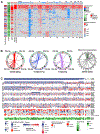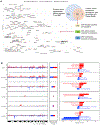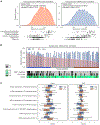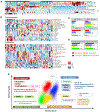Integrated Proteogenomic Characterization of Clear Cell Renal Cell Carcinoma
- PMID: 31675502
- PMCID: PMC7331093
- DOI: 10.1016/j.cell.2019.10.007
Integrated Proteogenomic Characterization of Clear Cell Renal Cell Carcinoma
Erratum in
-
Integrated Proteogenomic Characterization of Clear Cell Renal Cell Carcinoma.Cell. 2020 Jan 9;180(1):207. doi: 10.1016/j.cell.2019.12.026. Cell. 2020. PMID: 31923397 No abstract available.
Abstract
To elucidate the deregulated functional modules that drive clear cell renal cell carcinoma (ccRCC), we performed comprehensive genomic, epigenomic, transcriptomic, proteomic, and phosphoproteomic characterization of treatment-naive ccRCC and paired normal adjacent tissue samples. Genomic analyses identified a distinct molecular subgroup associated with genomic instability. Integration of proteogenomic measurements uniquely identified protein dysregulation of cellular mechanisms impacted by genomic alterations, including oxidative phosphorylation-related metabolism, protein translation processes, and phospho-signaling modules. To assess the degree of immune infiltration in individual tumors, we identified microenvironment cell signatures that delineated four immune-based ccRCC subtypes characterized by distinct cellular pathways. This study reports a large-scale proteogenomic analysis of ccRCC to discern the functional impact of genomic alterations and provides evidence for rational treatment selection stemming from ccRCC pathobiology.
Keywords: CPTAC; ccRCC; chromosomal translocation; drug targets; immune infiltration; phosphoproteomics; proteogenomics; proteomics; renal carcinoma; tumor microenvironment.
Copyright © 2019 Elsevier Inc. All rights reserved.
Conflict of interest statement
DECLARATION OF INTERESTS
Dr. Eric Schadt serves as Chief Executive Officer for Sema4 and has an equity interest in this company.
Figures







Comment in
-
Proteomic signatures of clear cell renal cell carcinoma.Nat Rev Nephrol. 2020 Mar;16(3):133-134. doi: 10.1038/s41581-019-0233-5. Nat Rev Nephrol. 2020. PMID: 31780818 No abstract available.
References
Publication types
MeSH terms
Substances
Grants and funding
LinkOut - more resources
Full Text Sources
Other Literature Sources
Miscellaneous

